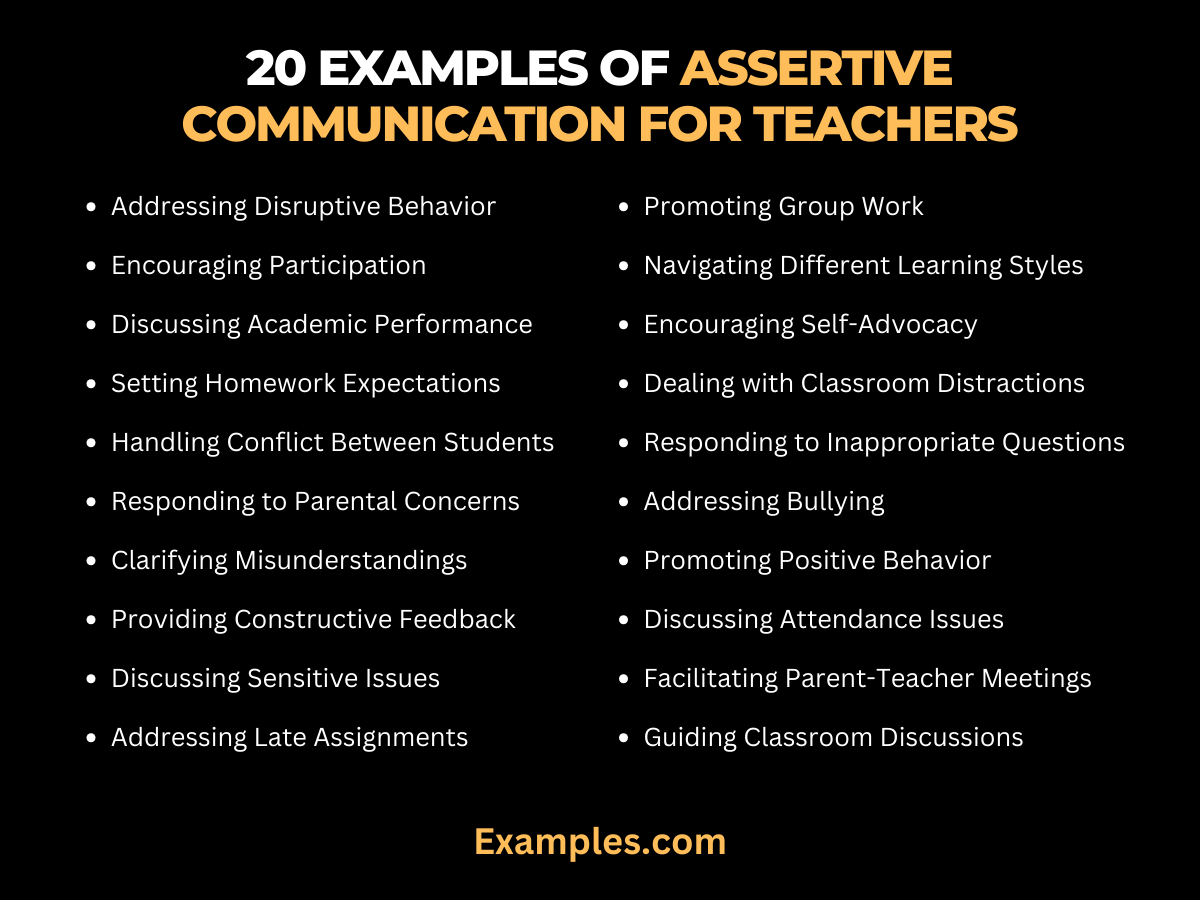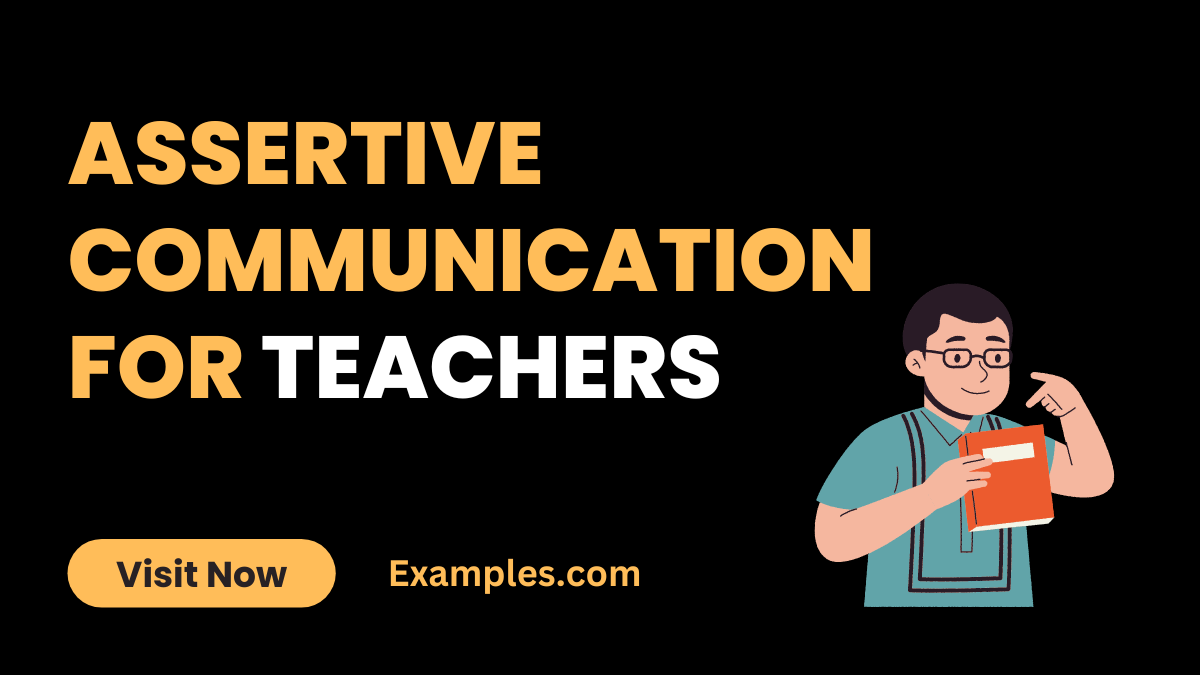19+ Assertive Communication for Teachers Examples
Discover the essence of assertive communication for teachers in our comprehensive guide, designed to enhance your teaching approach with practical and effective strategies. This guide delves into the art of balancing assertiveness and empathy in the classroom, showcasing oral communication examples that demonstrate how to express yourself clearly and respectfully. From managing classroom dynamics to fostering positive interactions, our guide is an invaluable resource for educators aiming to communicate more effectively with their students. Join us in mastering the nuances of assertive communication, a key skill for successful teaching.
20 Examples of Assertive Communication for Teachers
Assertive communication is an essential tool for teachers, fostering an environment of respect, understanding, and effective learning. This guide offers 20 distinctive examples, showcasing how teachers can apply assertive communication in the classroom. Each example, infused with Assertive Communication Skills, demonstrates clear and respectful ways to address various situations. From managing classroom dynamics to engaging with parents and students, these scenarios highlight the importance of empathy, respectful tone, and clear expression in educational settings.

- Addressing Disruptive Behavior: “I need everyone to be quiet when I’m speaking. It’s important so we can all learn.”
The teacher firmly sets classroom expectations while emphasizing the importance of learning for all. - Encouraging Participation: “I’d love to hear from someone who hasn’t spoken up yet. Your thoughts are valuable.”
This approach encourages quieter students to share their ideas in a supportive environment. - Discussing Academic Performance: “I’ve noticed you’re struggling with this topic. How can I support your learning?”
The teacher shows concern and willingness to help, fostering a supportive learning atmosphere. - Setting Homework Expectations: “Homework needs to be submitted on time to ensure you get the most from this class.”
Clear guidelines are provided, emphasizing the importance of responsibility. - Handling Conflict Between Students: “Let’s discuss this calmly and find a solution that works for both of you.”
The teacher mediates conflict with a focus on respectful resolution. - Responding to Parental Concerns: “I understand your concerns about the curriculum. Let’s discuss how it benefits your child’s learning.”
The teacher addresses concerns directly, providing clarity and reassurance. - Clarifying Misunderstandings: “Let me clarify the instructions to make sure we all understand the assignment.”
Proactive clarification prevents confusion and ensures understanding. - Providing Constructive Feedback: “Your essay was good, but adding more examples will make it even stronger.”
Feedback is given in a positive, constructive manner. - Discussing Sensitive Issues: “This topic can be challenging. I’m here to support you through this discussion.”
The teacher creates a safe space for difficult conversations. - Addressing Late Assignments: “I notice you’ve been submitting work late. Is there something preventing you from completing it on time?”
The teacher shows concern while seeking to understand underlying issues. - Promoting Group Work: “For this project, everyone’s input is important. Let’s make sure everyone contributes.”
Encourages equal participation and teamwork. - Navigating Different Learning Styles: “I see you learn better visually. Let’s find ways to incorporate that into your study.”
The teacher acknowledges and adapts to different learning needs. - Encouraging Self-Advocacy: “If you don’t understand something, please ask. It’s okay to need help.”
Promotes a culture where seeking help is viewed positively. - Dealing with Classroom Distractions: “Using phones during class distracts others. Please keep them away until the break.”
Sets clear rules about phone use, highlighting its impact on others. - Responding to Inappropriate Questions: “That question isn’t relevant to our topic. Let’s focus on our lesson.”
Steers the conversation back to the subject matter in a respectful way. - Addressing Bullying: “Bullying is not tolerated. Let’s talk about why it’s harmful and how we can prevent it.”
Takes a firm stand against bullying while educating about its impact. - Promoting Positive Behavior: “I appreciate how you helped your classmate. That’s a great example of teamwork.”
Recognizes and reinforces positive behavior in the classroom. - Discussing Attendance Issues: “Your regular attendance is important for your learning. Can we discuss what’s causing these absences?”
Expresses concern and seeks to address the root cause of absenteeism. - Facilitating Parent-Teacher Meetings: “Let’s use this time to discuss how we can work together to support your child’s education.”
Focuses on collaboration and support during parent-teacher interactions. - Guiding Classroom Discussions: “I appreciate your enthusiasm, but let’s give others a chance to share their views too.”
Balances participation, ensuring all students have the opportunity to contribute.
Teachers Assertive Communication Skills in Classroom
Explore the dynamic world of assertive communication skills in the classroom, essential for every modern educator. This guide highlights practical techniques to convey confidence and respect, fostering an environment where both teachers and students thrive. Embrace these skills to revolutionize classroom interactions, ensuring clear, empathetic, and effective communication.

- Setting Clear Expectations: Before starting a lesson, assertively articulate the objectives and rules. This sets a respectful tone and clarifies expectations, ensuring students know what is required of them.
- Active Listening During Discussions: Show attentiveness and respect by actively listening to students’ contributions, fostering a safe space for sharing ideas.
- Using ‘I’ Statements: When addressing behavior issues, use statements like, “I feel disrupted when…” to express your feelings without blaming students.
- Providing Constructive Feedback: Offer feedback that is specific and actionable, helping students understand how to improve.
- Firmly Handling Disruptions: Assertively, yet calmly, address disruptions, maintaining control while showing respect for the learning environment.
- Encouraging Student Participation: Invite quiet students into discussions with open-ended questions, valuing their input and encouraging engagement.
- Negotiating Classroom Rules: Collaborate with students to establish rules, demonstrating respect for their opinions and fostering a sense of ownership.
- Addressing Conflicts Directly: When conflicts arise, address them promptly and fairly, using clear communication to resolve issues.
- Expressing Empathy: Show understanding for students’ challenges and perspectives, building trust and rapport.
- Reinforcing Positive Behavior: Acknowledge and praise positive behaviors and achievements, encouraging a supportive and motivating classroom culture.
Activities to Teach Assertive Communication for Students
Delve into activities to teach assertive communication for students, a crucial element in developing their interpersonal skills. This guide presents engaging and practical activities that educators can incorporate into their curriculum to help students master the art of assertive communication.

- Role-Playing Scenarios: Create real-life situations where students practice assertive communication, such as expressing an opinion or addressing a conflict.
- ‘I Statement’ Exercises: Teach students to express their feelings using ‘I’ statements, enhancing emotional intelligence and communication skills.
- Feedback Circle: Students give and receive constructive feedback in a controlled setting, learning the importance of respectful communication.
- Boundary Setting Workshops: Engage students in activities that help them understand and practice setting healthy boundaries.
- Conflict Resolution Games: Use interactive games to teach strategies for resolving conflicts assertively and respectfully.
- Empathy Building Activities: Activities that foster empathy, helping students understand and respect diverse perspectives.
- Assertive vs Aggressive Role Play: Illustrate the difference between assertive and aggressive communication through guided role play.
- Positive Affirmation Sessions: Encourage students to practice positive affirmations, boosting confidence in their communication abilities.
- Listening Skills Exercises: Develop active listening skills through games and exercises, emphasizing the importance of understanding others.
- Communication Style Discussions: Facilitate discussions about different communication styles, helping students identify and develop their assertive communication techniques.
How Does Assertive Communication Help Teachers?
Assertive communication is an indispensable skill for teachers, playing a pivotal role in classroom management and fostering a positive learning environment. By embracing assertive communication, educators can effectively navigate the challenges of teaching, ensuring that their message is conveyed clearly and respectfully.
- Enhances Classroom Management: Assertive communication equips teachers with the ability to manage classroom dynamics efficiently. By being clear, direct, and respectful, teachers can set firm boundaries and expectations, which are crucial for maintaining an orderly and productive classroom. This approach reduces misunderstandings and minimizes disruptions, creating a more focused learning atmosphere.
- Builds Respect and Trust: When teachers communicate assertively, they demonstrate respect for themselves and their students. This mutual respect fosters a trusting relationship, essential for an effective learning environment. Assertive teachers are seen as confident and fair, qualities that encourage students to engage more openly and honestly in the classroom.
- Improves Conflict Resolution: Conflicts, whether between students or involving the teacher, are inevitable in a classroom setting. Assertive communication is key in resolving these conflicts constructively. By addressing issues directly and calmly, teachers can de-escalate tensions and find solutions that are acceptable to all parties involved.
- Encourages Student Participation: An assertive teacher creates a safe space for students to express their opinions and ask questions. This inclusive approach encourages shy or reluctant students to participate, enhancing their learning experience and confidence.
- Facilitates Clear and Effective Communication: Assertive communication is characterized by clarity and directness, which helps in conveying instructions and feedback effectively. This clarity prevents misunderstandings and ensures that students clearly understand the lesson content and expectations.
- Promotes Professional Growth: For teachers, developing assertive communication skills is a journey that contributes significantly to their professional growth. It not only improves their teaching effectiveness but also enhances their interactions with colleagues, parents, and administrators.
- Supports Personal Well-Being: Teachers who communicate assertively experience less stress and burnout. By expressing their needs and concerns effectively, they can maintain a healthy work-life balance, which is essential for long-term career sustainability.
Why is Assertiveness Important for Teachers?
Assertiveness is a cornerstone skill for teachers, fundamental to creating an effective and positive learning environment. Emphasizing assertive communication, this guide explains why assertiveness is crucial for educators.
- Establishes Clear Communication: Assertiveness allows teachers to communicate their expectations and instructions clearly, reducing confusion and misunderstandings in the classroom. This clarity is essential for effective teaching and learning.
- Builds a Positive Classroom Atmosphere: Assertive teachers create a respectful and inclusive classroom environment. This positive atmosphere encourages students to engage, participate, and take risks in their learning journey.
- Fosters Mutual Respect: Teachers who communicate assertively are respected by their students. This respect is reciprocal, creating a classroom culture where every individual feels valued and heard.
- Enhances Professional Credibility: Assertive communication demonstrates confidence and competence, essential traits for professional credibility. Teachers who communicate assertively are often viewed as more capable and reliable.
- Improves Conflict Management: Teachers frequently encounter conflicts, whether between students or in their interactions. Assertiveness is key in addressing and resolving these conflicts effectively and amicably.
- Encourages Student Autonomy: By modeling assertive communication, teachers encourage students to express themselves assertively, fostering independence and self-advocacy skills in students.
- Supports Teacher Advocacy: Assertiveness enables teachers to advocate for their needs, whether it’s for resources, support, or professional development. This self-advocacy is essential for their career growth and job satisfaction.
- Reduces Stress and Burnout: Assertive communication helps in setting boundaries, which is vital for managing workload and reducing stress. Teachers who can assertively say ‘no’ to unreasonable demands are less likely to experience burnout.
What are 10 Characteristics of Assertive Teachers?
Assertive teachers exhibit a set of distinct characteristics that set them apart and make them effective in their profession. Here are ten key traits:
- Confident: Assertive teachers display confidence in their knowledge and teaching abilities, inspiring trust and respect in their students.
- Empathetic: They show a deep understanding of students’ feelings and perspectives, fostering a supportive learning environment.
- Respectful: Assertiveness is not about dominance; these teachers treat students with respect, valuing their opinions and individuality.
- Clear Communicators: They articulate their thoughts and instructions clearly and concisely, ensuring that students understand classroom expectations.
- Active Listeners: Assertive teachers are attentive listeners, acknowledging students’ contributions and addressing their concerns.
- Solution-Oriented: Faced with challenges, they focus on finding constructive solutions rather than dwelling on problems.
- Consistent: Consistency in enforcing rules and expectations is a hallmark of assertive teachers, providing a stable and predictable learning environment.
- Open and Honest: They communicate honestly, providing genuine feedback and expressing their thoughts in a straightforward manner.
- Self-Aware: These educators are aware of their strengths and weaknesses and strive for continuous professional development.
- Boundary Setters: Assertive teachers effectively set and maintain boundaries, balancing their professional responsibilities with personal well-being.



